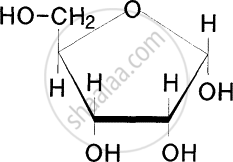Advertisements
Advertisements
प्रश्न
Draw the structure of α-D glucopyranose.
उत्तर

संबंधित प्रश्न
Write the name of the unit to which glucose unit is linked to from sucrose.
What is the action of the following reagents on glucose?
hydroxylamine
Explain D and L configuration in sugars.
By which of the following process formation of glycosidic bond occurs?
Identify the given structure 'P' and 'Q'.


Which of the following monosaccharides is a tetrose sugar?
Which of the following is the basic unit of carbohydrates?
Which of the following carbohydrate is sweet to taste?
Carbohydrates can contain which of the following chemical groups?
Identify the WRONG statement.
Match the Column I and Column II select the correct option.
| Column I | Column II | ||
| i. | Monosaccharides | a. | Stored energy in animals |
| ii. | Glycogen | b. | Polymer made from ß-glucose molecules |
| iii. | Cellulose | c. | Exoskeleton of arthropods |
| iv. | Chitin | d. | Building blocks of carbohydrates |
| e. | Plant hormone |
The number of asymmetric carbon atoms in the glucose molecule is ____________.
____________ do not give smaller sugar units on hydrolysis.
Identify the INCORRECT statement regarding glucose.
One mole of a carbohydrate on hydrolysis gives one mole of glucose and one mole of galactose. Identify the carbohydrate.
Glucose and gluconic acid treated with dilute nitric acid forms saccharic acid. What does this indicate?
Identify the number of secondary carbon atoms in glucose.
Which one of the following rotates the plane polarized light towards left?
Assertion: A solution of sucrose in water is dextrorotatory. But on hydrolysis in the presence of little hydrochloric acid, it becomes levorotatory.
Reason: Sucrose hydrolysis gives equal amounts of glucose and fructose. As a result of this change in sign of rotation is observed.
Why carbohydrates are generally optically active?
Classify the following into monosaccharides, oligosaccharides and polysaccharides.
Maltose
If 'n' represents total number of asymmetric carbon atoms in a compound, then the possible· number of optical isomers of the compound is ______.
Corn is immersed in boiling water. It is then cooled, and the solution becomes sweet. It is due to ______.
Which one is a non-reducing commercial sugar?
Why carbohydrates are generally optically active.
Why are carbohydrates generally optically active?
